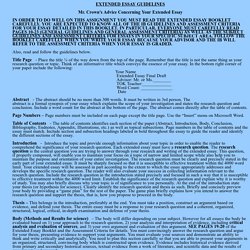

Beyond Google + Online Tools. Project Qualification. Www.crickhowell-hs.powys.sch.uk/wp-content/uploads/2009/11/Essential-Study-Skills.pdf. Www.crickhowell-hs.powys.sch.uk/wp-content/uploads/2009/11/Essential-Study-Skills.pdf. Course: Extended Project Qualification. Course: Extended Project Qualification. Course: Extended Project Qualification. EXTENDED ESSAY GUIDELINES. Mr.

Crown's Advice Concerning Your Extended Essay Also, read and follow the guidelines below. Title Page - Place the title ¼ of the way down from the top of the page. Remember that the title is not the same thing as your research question or topic. Think of an informative title which conveys the essence of your essay. Your Name Extended Essay Final Draft Advisor: Mr. or Ms TOK Teacher:_____________ Word Count: ______________ Date Abstract - The abstract should be no more than 300 words.
Abstract is a formal synopsis of your essay which explains the scope of your investigation and states the research question and conclusion. Page Numbers – Page numbers must be included on each page except the title page. Table of Contents - The table of contents identifies each section of the paper (Abstract, Introduction, Body, Conclusion, Bibliography, Endnotes, Appendix, Illustrations, etc.) as well as topical subsections.
Thesis – This belongs in the introduction, preferably at the end. Library@King's - EPQ Extended Project Qualification. Library@King's - EPQ Useful websites. Referencing & Bibliographies - St Wilfrid's Extended Project Qualification. Epq.stwilfrids.com/uploads/1/3/2/1/13219974/quick_guide_to_harvard_referencing.pdf. Www.johnlyon.org/docs/123-EPQResearch.pdf. Bibliographic citation and referencing - University of Warwick Library. Why reference?

From reading academic articles and books, you should be familiar with the scholarly practice of making references in the text to other people's work and providing listings of relevant source material at the end of the text. Why is this done, and why should you adopt this approach in your own work? There are several reasons: To enable someone reading the document to find the material you have referred to or consulted To demonstrate your width of reading and knowledge about a subject To support and/or develop points made in the text To avoid accusations of plagiarism: using somebody else's work without acknowledging the fact and Because you may be required to do so by your department You can use the Endnote Online software to automatically format your bibliographies and references lists in the correct way for your required style. Terminology In discussions on this topic, reference is variously made to "citations", to "references lists" and to "bibliographies".
Harvard style. Anglia Ruskin University Library - Harvard System. Any in-text reference should include the authorship and the year of the work.

Depending on the nature of the sentence/paragraph that is being written, references to sources may be cited in the text as described below: Additional support on how to introduce such references is available from Student Support in their guide. When making reference to an author's whole work in your text, it is sufficient to give the name followed by the year of publication of their work: When writing for a professional publication, it is good practice to make reference to other relevant published work. This view has been supported by Cormack (1994). However, where you are mentioning a particular part of the work, and making direct or indirect reference to this, a page reference should be included: Cormack (1994, pp.32-33) states that "when writing for a professional readership, writers invariably make reference to already published works".
For more examples, see page numbers section. Directly using an and. Libweb.anglia.ac.uk/articulate/Using your Information/story.html?libguide=1. Libweb.anglia.ac.uk/referencing/files/QuickHarvardGuide2013Aug.pdf. Www.library.hbs.edu/guides/citationguide.pdf. MLAPoster09.jpg (4320×3240) MLA Formatting and Style Guide. Coming Soon: A new look for our same great content!

We're working hard this summer on a redesign of the Purdue OWL. Worry not! Our navigation menu and content will remain largely the same. Summary: MLA (Modern Language Association) style is most commonly used to write papers and cite sources within the liberal arts and humanities. Contributors: Tony Russell, Allen Brizee, Elizabeth Angeli, Russell Keck, Joshua M. The following overview should help you better understand how to cite sources using MLA eighth edition, including the list of works cited and in-text citations. Please use the example at the bottom of this page to cite the Purdue OWL in MLA. Creating a Works Cited list using the eighth edition MLA is a style of documentation based on a general methodology that may be applied to many different types of writing. Thus, the current system is based on a few guiding principles, rather than an extensive list of specific rules. Here is an overview of the process: Author Said, Edward W.